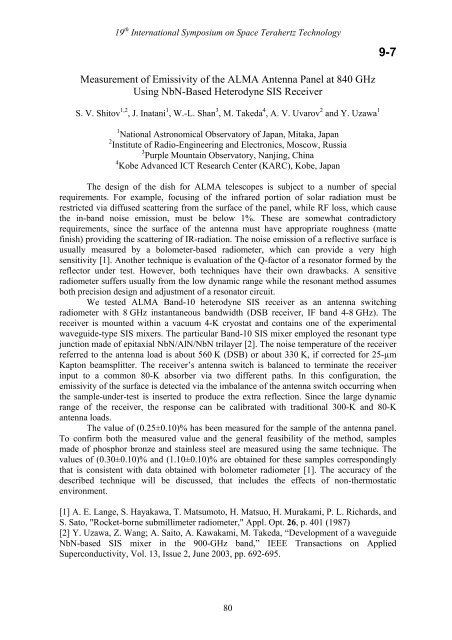Program and Abstract Book - SRON
Program and Abstract Book - SRON
Program and Abstract Book - SRON
You also want an ePaper? Increase the reach of your titles
YUMPU automatically turns print PDFs into web optimized ePapers that Google loves.
19 th International Symposium on Space Terahertz Technology<br />
9-7<br />
Measurement of Emissivity of the ALMA Antenna Panel at 840 GHz<br />
Using NbN-Based Heterodyne SIS Receiver<br />
S. V. Shitov 1,2 , J. Inatani 1 , W.-L. Shan 3 , M. Takeda 4 , A. V. Uvarov 2 <strong>and</strong> Y. Uzawa 1<br />
1 National Astronomical Observatory of Japan, Mitaka, Japan<br />
2 Institute of Radio-Engineering <strong>and</strong> Electronics, Moscow, Russia<br />
3 Purple Mountain Observatory, Nanjing, China<br />
4 Kobe Advanced ICT Research Center (KARC), Kobe, Japan<br />
The design of the dish for ALMA telescopes is subject to a number of special<br />
requirements. For example, focusing of the infrared portion of solar radiation must be<br />
restricted via diffused scattering from the surface of the panel, while RF loss, which cause<br />
the in-b<strong>and</strong> noise emission, must be below 1%. These are somewhat contradictory<br />
requirements, since the surface of the antenna must have appropriate roughness (matte<br />
finish) providing the scattering of IR-radiation. The noise emission of a reflective surface is<br />
usually measured by a bolometer-based radiometer, which can provide a very high<br />
sensitivity [1]. Another technique is evaluation of the Q-factor of a resonator formed by the<br />
reflector under test. However, both techniques have their own drawbacks. A sensitive<br />
radiometer suffers usually from the low dynamic range while the resonant method assumes<br />
both precision design <strong>and</strong> adjustment of a resonator circuit.<br />
We tested ALMA B<strong>and</strong>-10 heterodyne SIS receiver as an antenna switching<br />
radiometer with 8 GHz instantaneous b<strong>and</strong>width (DSB receiver, IF b<strong>and</strong> 4-8 GHz). The<br />
receiver is mounted within a vacuum 4-K cryostat <strong>and</strong> contains one of the experimental<br />
waveguide-type SIS mixers. The particular B<strong>and</strong>-10 SIS mixer employed the resonant type<br />
junction made of epitaxial NbN/AlN/NbN trilayer [2]. The noise temperature of the receiver<br />
referred to the antenna load is about 560 K (DSB) or about 330 K, if corrected for 25-µm<br />
Kapton beamsplitter. The receiver’s antenna switch is balanced to terminate the receiver<br />
input to a common 80-K absorber via two different paths. In this configuration, the<br />
emissivity of the surface is detected via the imbalance of the antenna switch occurring when<br />
the sample-under-test is inserted to produce the extra reflection. Since the large dynamic<br />
range of the receiver, the response can be calibrated with traditional 300-K <strong>and</strong> 80-K<br />
antenna loads.<br />
The value of (0.25±0.10)% has been measured for the sample of the antenna panel.<br />
To confirm both the measured value <strong>and</strong> the general feasibility of the method, samples<br />
made of phosphor bronze <strong>and</strong> stainless steel are measured using the same technique. The<br />
values of (0.30±0.10)% <strong>and</strong> (1.10±0.10)% are obtained for these samples correspondingly<br />
that is consistent with data obtained with bolometer radiometer [1]. The accuracy of the<br />
described technique will be discussed, that includes the effects of non-thermostatic<br />
environment.<br />
[1] A. E. Lange, S. Hayakawa, T. Matsumoto, H. Matsuo, H. Murakami, P. L. Richards, <strong>and</strong><br />
S. Sato, "Rocket-borne submillimeter radiometer," Appl. Opt. 26, p. 401 (1987)<br />
[2] Y. Uzawa, Z. Wang; A. Saito, A. Kawakami, M. Takeda, “Development of a waveguide<br />
NbN-based SIS mixer in the 900-GHz b<strong>and</strong>,” IEEE Transactions on Applied<br />
Superconductivity, Vol. 13, Issue 2, June 2003, pp. 692-695.<br />
80
















